If you find yourself in want or need of a ukulele, there are several specifications that may guide or determine your decision. The first to address is what size you desire. Ukuleles can be found or crafted into several different sizes, and each size uses a categorization of vocal ranges in relation to the size, from highest to lowest pitch corresponding with smallest to largest size.
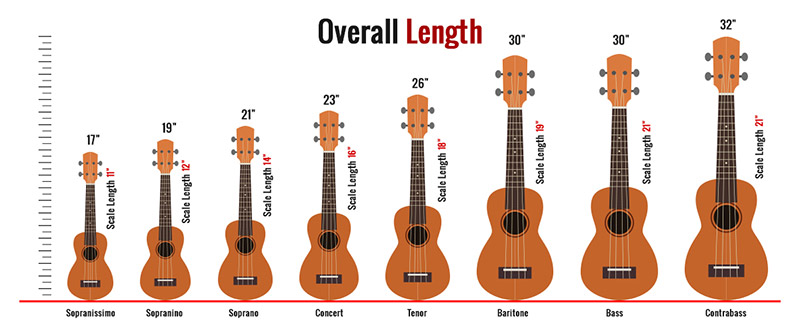
The most common sizes are the soprano, concert, and tenor ukuleles, and most ukulele music is written for those three. The baritone ukulele has become more popular in recent years and is included with the previous three as the main four sizes. The sopranino, bass, and contrabass ukuleles are far less common, but also a part of the ukulele family and great options for amateurs, professionals, and collectors alike.
The sizing of a ukulele is measured by its overall length from top to bottom and the scale length. The scale length of each ukulele refers to the distance from the nut to the saddle, which is basically the section of the strings that vibrate. The scale length will determine how far apart the frets are on the fretboard, while the overall length is the measurement of the entire instrument from the top of the headstock to the bottom of the body. The number of frets of any given size can vary, but in general, the larger the uke, the more frets it will have, and therefore more range.
It should be noted that there isn’t a universal standard for ukulele sizes. Measurements may vary slightly depending on the manufacturer and change over time, but the measurements mentioned below will be within the general ball-park of most ukuleles. Let’s examine each size of ukulele in further detail starting with the smallest.
Table of Contents
Here Are the Different Sizes of Ukuleles
1. Sopranissimo (Smallest)
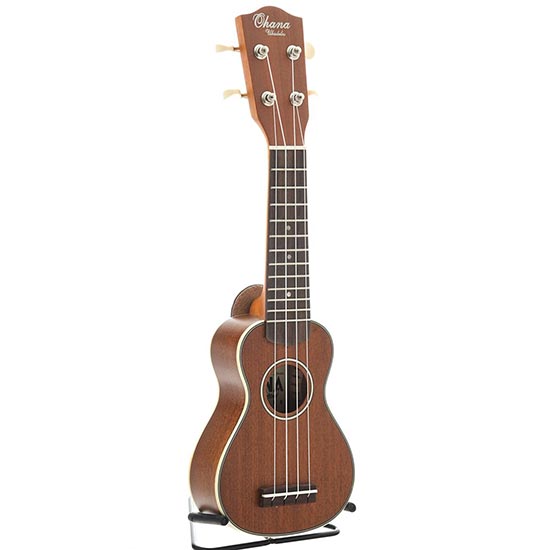
Often referred to as the “pocket” uku, the sopranissimo is the smallest size of ukulele commercially made. Its typical length from top to bottom is around 16-17 inches, it has 10-12 frets, and its scale length is 11 inches. This scale length is 1 inch shorter than the sopranino and 2 inches shorter than the soprano.
This tiny ukulele is so small it can fit into a handbag, tote, or backpack (or some pockets, I would presume) and is quite portable. It is also sometimes called the “mini”, “pocket”, or “tiny” ukulele due to its minuscule dimensions. Several ukulele makers offer models of the sopranissimo size, however, the names vary and will sometimes refer to the ukulele by one of the previously mentioned nicknames.
The tuning of this specialty ukulele is flexible. Some players claim the best sound is achieved by tuning the smallest ukuleles up a bit higher than a standard tuning to achieve more volume and projection, but opinions vary. The string gauge will need to be taken into account. If equipped with soprano strings, the tuning will only go so high, but if equipped with strings made for such a small instrument, there are more options. If you wish to produce higher string tension for a bright, sparkly sound, try tuning higher than the standard G-C-E-A tuning. In theory, the tuning is really up to the player. Commonly discussed tunings include a step higher (A-D-F#-B), a step and a half higher (Bb-Eb-G-C) a fifth higher (D-G-B-E), and an octave higher than standard tuning.
Ohana offers a popular short-scale series that features sopranissimo ukuleles called the O’Nino and O’Nina, and even features a pineapple sopranissimo. Kala also offers the sopranissimo size but calls theirs the pocket uke.
2. Sopranino
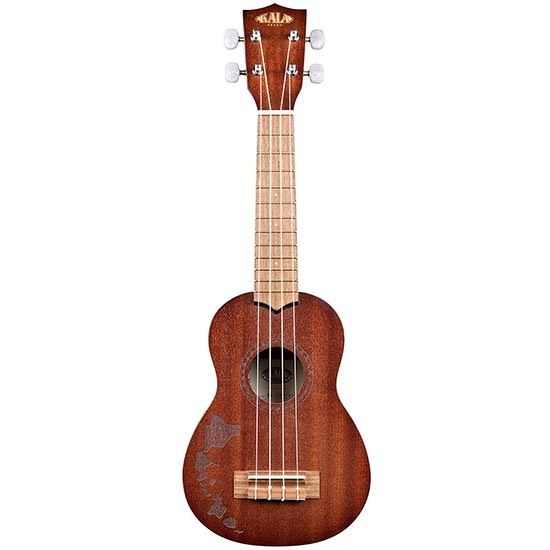
With a 12-inch scale length and an overall length of around 18-19 inches, the sopranino is only slightly larger than the sopranissimo ukulele. The two of them are often confused for the other, however, there is a minute difference in size.
Tuning for this instrument is also debatable and really up to the player. Some players opt for the standard soprano tuning of G-C-E-A, however, others like to add more string tension for the smaller sopranino for the same reasons as the sopranissimo. Most commonly, the sopranino is tuned one octave higher than the baritone ukulele at D-G-E-A. In theory, the sopranino ukulele would sound best a tone and a half higher than standard tuning at Bb-Eb-G-C because it is typically three frets smaller than the soprano.
The sopranino ukulele is often revered as the predecessor size of the soprano ukulele because it is believed that the first soprano ukuleles were slightly smaller than the current standard soprano ukulele. Many companies that make sopranino ukuleles like to offer vintage-style models to commemorate the origins of the ukulele.
Other commonly seen names for the sopranino are the “piccolo” or “bambino” ukulele. Ohana’s short-scale series has a few sopranino ukuleles including the Pequeno and pineapple sopaninos. Ortega guitars also provide a sopranino ukulele called the Keiki.
3. Soprano
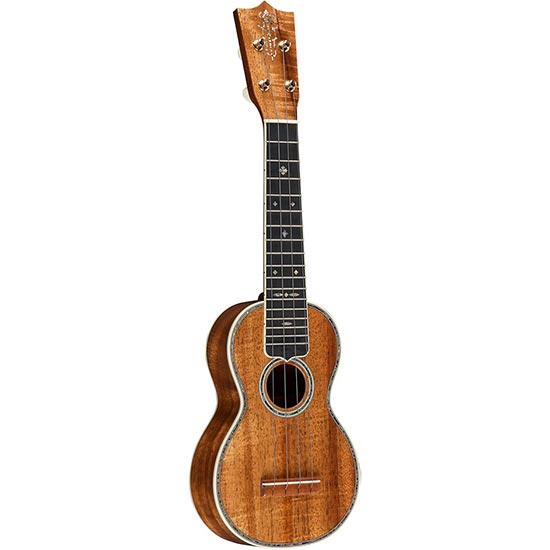
The soprano ukulele is considered to be one of the main sizes of ukulele with a scale length of 13-14 inches. It is typically around 20-21 inches long with 12-15 frets on a standard neck. It is the most common ukulele size loved for its traditional, classic ukulele sound.
The very first ukuleles are believed to have been soprano sized, so it is often referred to as the standard or classic size of ukulele and is the most popular. In Hawaii, the soprano is often referred to as the standard. Along with the pahu, a traditional Hawaiian drum, the ukulele is an official instrument of the state of Hawaii.
The standard ukulele tuning of G-C-E-A is used on the soprano, although some traditionalists will opt for the Hawaiian tuning of A-D-F#-B. Younger players may wish to keep it in standard tuning so that the strings are easier to press down. The higher the tuning, the higher the string tension will be which requires a small amount more pressure from the fingers on the fretboard.
Soprano ukuleles are short scale but are slightly larger than the sopranino. The tone of the soprano ukulele is bright but lacks the same projection and warmth found in the larger ukulele family members. Due to the smaller size, soprano ukes are a great option for beginners and players with smaller hands or fingers. Those with larger hands and fingers may have some trouble due to the frets being closer together, but less so with this instrument versus the previous two. Chords will be much more accessible in general due to the close proximity of the frets.
The smaller size usually offers lower prices because fewer materials are required to make it of course. This is great for players just starting out but not ready to make a large monetary investment in a more expensive instrument. Be wary of poor quality ukuleles though. While there are a lot of excellent soprano ukuleles on the market, there are also a lot of cheap, low-quality ones too. You should expect to spend at least around $50 on even the most budget-friendly soprano ukulele to get a decent, playable instrument.
Anyone who makes ukuleles will offer a soprano size since it is the most popular. There is a wide variety to choose from too, including the beloved pineapple shape, various colors and styles, and countless tonewood options. You can find soprano ukuleles sold online and in music shops around the world. The model name of a soprano size ukulele will oftentimes include an “S” in the name, but not always. A few of the most popular soprano ukuleles include the Kala KA-15S and the Martin OXK.
4. Concert
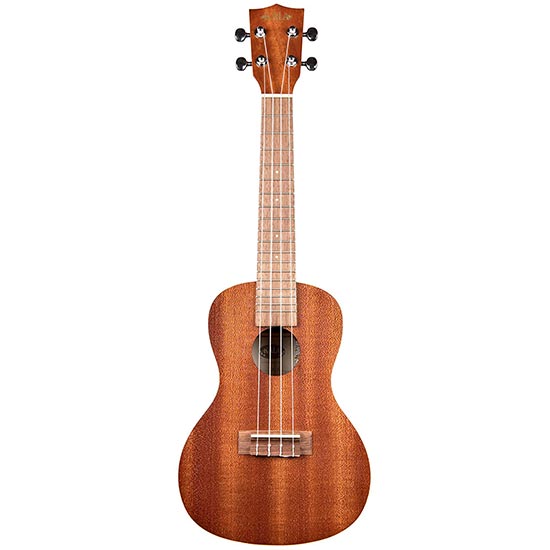
The concert ukulele made its first appearance in 1920 and was marketed as the “large” ukulele. Slightly larger than the soprano, the concert ukulele is like the alto voice of the ukulele family. It is around 23 inches long overall with a scale length of 15-16 inches. There are typically 15-20 frets on the concert ukulele.
The warmer, richer tone will be heard in the concert ukulele in comparison with the soprano size due to its slightly taller neck and body. It can also project more sound because it is larger, however, it is still small enough to be easily handled and carried around.
The longer scale is found to be more comfortable for many players because there is more space between the frets, which provides more room for the fingers. Many also find the larger size to fit their posture more easily, but this varies from person to person.
Standard tuning is the usual for the concert ukulele, like the soprano, which is the “re-entrant” tuning of G-C-E-A. Re-entrant refers to the strings of the instrument not being arranged from low to high in pitch. The G is higher than the C and the E, even though it is the top string closest to the player. Like the previously discussed sizes, tuning is changeable and some players may prefer a tuning that is not the standard.
Concert ukuleles are found anywhere ukuleles are sold. It is almost as popular as the soprano size, so you can find it in a variety of woods, shapes, colors, styles, and shapes including the pineapple shape. It is generally a good fit for beginners and players with larger hands and is highly recommended if you are looking for a standard ukulele with no particular preference. The letter “C” will often be included in the model name of the ukulele, if not the word “concert”. The Luna Tattoo Concert ukulele, Martin C1K, and Kala KA-C are a few reputable concert size ukuleles.
Popular Related Article: The 15 Types of Ukuleles (with Images)
5. Tenor Ukulele
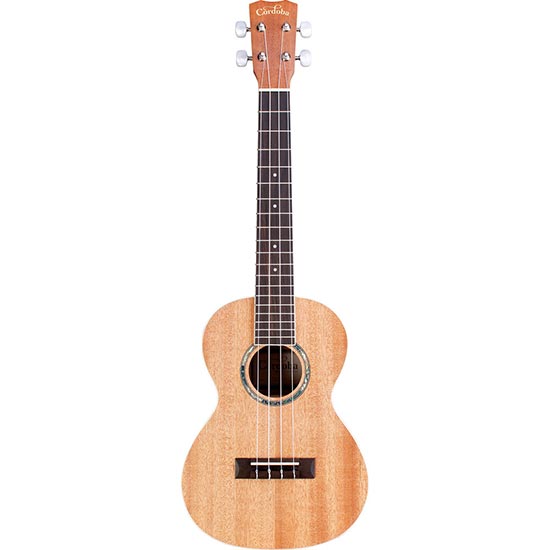
The tenor ukulele first hit the scene in the 1920s, at least under the label of a tenor ukulele. There may have been tenor-sized ukuleles before this, but the name tenor ukulele wasn’t seen marketed as a size until the 1920s.
With a total length of 26 inches, the tenor ukulele can hold around 15-25 frets. Its scale length is 17-18 inches. While it is larger than the concert ukulele, it is still not as big as a normal-sized guitar. It is a bit heavier than the soprano or concert ukulele of course, so it isn’t seen as being as portable as the previously discussed sizes.
Favored by most stage performers, the tenor ukulele has a deeper, more complex sound and is used for more advanced music. The wide frets and larger body is often preferred by intermediate and advanced players. The long scale offers the opportunity to progress into more challenging music and use a broader range of notes, and many find it comfortable to play as well. The size of the tenor fits most adult players, and some players opt to use a strap to help balance the instrument, particularly if standing and playing.
Tenor ukuleles are often tuned either with the re-entrant tuning but are also often tuned in linear tuning. This means that the top string G may be tuned higher or lower. As previously mentioned, in re-entrant tuning, the G string is higher than the C and E, even though it is at the top. In linear tuning, the G is tuned an octave lower than that, making it the lowest string. The low G tuning is useful for accessing a larger range of notes in solo playing especially. If tuned with the higher G, the tenor ukulele is in the same octave as the soprano and plays the same notes. The difference lies in the resonance, depth, and sustain in the sound rather than the highness or lowness of the pitch itself.
Just about any ukulele maker will most likely offer a variety of tenor-size ukuleles from which to choose. It can be found in a wide variety of styles with the cutout being seen frequently on the tenor uke. The bigger the uke, the higher the price usually, but there are great tenor ukuleles out there for reasonable prices if you’re on a budget. Tenor ukulele models will likely have the letter “T” in their name, if not the name tenor itself. A few favorable tenors include the Kala KA-KTG, the Enya EUT-M6, and the Martine T1K.
6. Baritone Ukulele
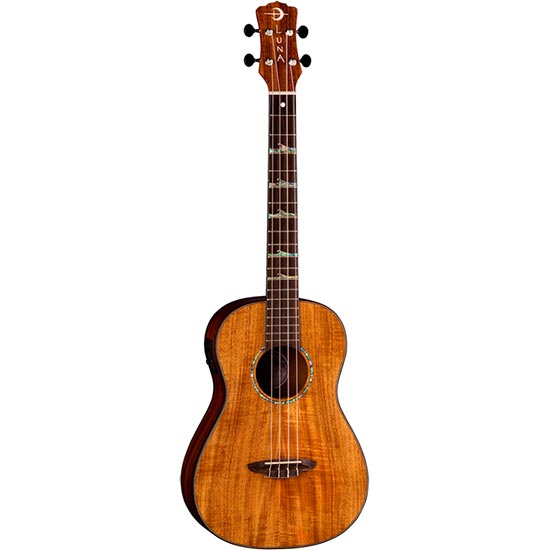
Of the four main types, the baritone ukulele is the largest. Its total length is around 29-30 inches and it has a scale length of 19-20 inches. Most baritone ukuleles will have at least 19 frets. Its large size offers the best resonance, bass sound, and deepest tones of our ukulele sizes thus far.
The baritone ukulele tuning is closely related to the guitar. The four strings of the baritone ukulele are the same as the bottom four strings of the guitar. The baritone ukulele does not use standard tuning, but rather D-G-B-E, which is a fourth lower than the standard G-C-E-A tuning.
Guitarists will favor the baritone ukulele over others because of the ease in transition. A guitar player will be able to pick the baritone ukulele up and play many songs immediately due to the familiar tuning. This means that the baritone ukulele cannot play from other ukulele music, however, because the notes and chords shown will not match the baritone’s unique tuning. If you are a ukulele player looking at trying a baritone, you may want to find or invest in a baritone ukulele-specific chord chart to help you adjust to the alternate chord names and notes.
Although the baritone ukulele is smaller than a regular guitar, it is of course less portable than the smaller ukulele sizes. Choices are slightly more limited because the baritone uke is more of a “niche” product, and not as widely manufactured as the soprano, concert, or tenor ukulele. It is often referred to as the largest ukulele, but it is actually the largest of the four main sizes. There are a few larger specialty ukuleles that will be mentioned in the following sections. Baritone ukuleles will often have the letter “B” in the model name. A few mentionable baritone models include the Kala KA-BG, the Luna VMB RDS, and the Lanikai FM-CEB.
Popular Related Article: The 20 Best Ukulele Brands
7. Bass Ukulele
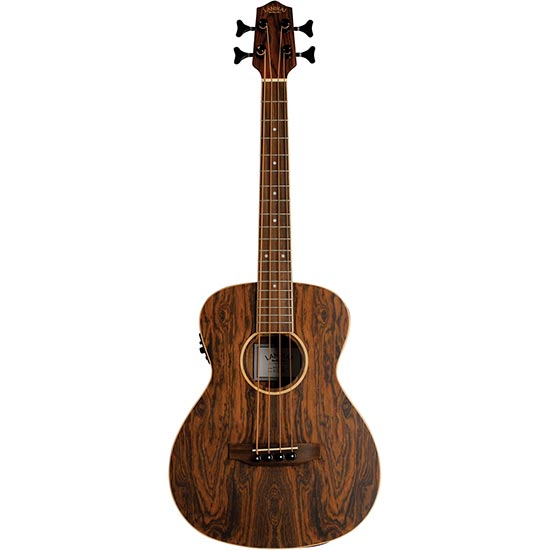
Slightly larger than the baritone ukulele, the bass ukulele is a specialty instrument. At around 30 inches in total length and a scale length of 21 inches or so, it is basically like a miniature bass guitar and sometimes is played like one. Some bass ukulele bodies are made to be the same size as the baritone, but the scale length will still differ. Be aware when shopping of what size you’d prefer.
The bass ukulele is seen as a hybrid instrument because of its similarities with the bass guitar. The tuning is shared with the bass guitar, with the four strings being E-A-D-G. Some bass ukuleles will sound an octave higher than a bass guitar, which is still significantly lower than the standard tuned ukuleles. There are some bass ukuleles that have the contrabass ukulele range, which matches the same octave as the bass guitar.
There are two main body types for the bass ukulele. The solid-body looks and sounds just like an electric bass, while the hollow body looks more like a ukulele or mini-guitar and sounds like an upright bass, otherwise known as the double bass. The bass ukulele must nearly always be amplified in order to really be heard because of the low string tension, so it is found as either an acoustic-electric or solid body electric, and you will likely need an amp. There are few models out there that can play without an amp, however some of these cross into the bari-bass category. A bari-bass ukulele is a baritone size body fitted with bass strings.
While the other ukulele sizes most commonly employ nylon strings, the bass ukulele uses polyurethane strings, which are much more dense and thick. Many players describe these strings as having a rubber band feel to them. There are other varieties used for the bass ukulele, such as silver or copper wound, but the polyurethane has proven to be a top choice among many players. Others find them to be very odd and advise time to adjust to the unique feeling of the strings.
The bass ukulele is often used as a traveling bass by bass guitar players. It is also useful if you play in a ukulele ensemble because it offers that low, bass sound to fill out a large group of ukuleles playing together. Bass uke is not meant for strumming chords, but rather for picking individual notes, like a bass guitar.
Bass ukulele is a recent addition to the ukulele family founded by Owen Holt, but it was not commercially popular until he collaborated with Kala founder Mike Upton. Upon their collaboration, the Kala U-Bass was born in 2009, which has become the most popular bass ukulele today. The Kala U-Bass is like the pioneer of the bass ukulele, and because of its increasing popularity, more choices have sprung into the market. Other mentionable bass ukulele makers include Hadean and Luna, and Kala offers several other bass ukulele models as well within its U-Bass line.
8. Contrabass (Largest)
Even slightly larger than the bass ukulele is the contrabass ukulele. At 32 inches in length, the contrabass ukulele is virtually the same as the bass ukulele, but a little bit larger and, by definition, sounds lower. There are some inconsistencies with the differences between contrabass and bass ukulele, and they are frequently discussed as the same instrument.
The tuning of the contrabass ukulele is also the same as the bass guitar, with the string tuned E-A-D-G from top to bottom. The distinguishing factor is that, technically, the contrabass ukulele is tuned in the same octave as the bass guitar, while the bass ukulele is an octave higher. While this is true by definition of the word “contra”, there are some discrepancies in its application. For example, the Kala U-Bass is actually a contrabass, because it sounds in the same octave as the bass guitar, but it is simply called a bass ukulele and not contrabass.
Essentially, the terms bass ukulele and contrabass ukulele are used interchangeably, so if shopping for one, be sure to check which octave its intended tuning is in so you get the sound you desire.
Popular Related Article: The Best Beginner Ukuleles (All Price Ranges)
Now that you’ve examined the different sizes of ukuleles there are out there, you hopefully have a better idea of which is the best for you. If you are still undecided between a few sizes, it is always helpful to test out the instruments to find your fit. Take into account what you plan to use the instrument for, especially if considering the specialty bass instrument. Perhaps you’d like something smaller for ease of travel such as one of the three smallest, or something with the biggest sound like the tenor or baritone. When trying out a ukulele for size, test out the sound and feel of the instrument, and choose the instrument that is most comfortable and offers the most desirable sound to you.

My name is Chris and I’ve had a passion for music and guitars for as long as I can remember. I started this website with some of my friends who are musicians, music teachers, gear heads, and music enthusiasts so we could provide high-quality guitar and music-related content.
I’ve been playing guitar since I was 13 years old and am an avid collector. Amps, pedals, guitars, bass, drums, microphones, studio, and recording gear, I love it all.
I was born and raised in Western Pennsylvania. My background is in Electrical Engineering, earning a Bachelor’s degree from Youngstown State University. With my engineering experience, I’ve developed as a designer of guitar amplifiers and effects. A true passion of mine, I’ve designed, built, and repaired a wide range of guitar amps and electronics. Here at the Guitar Lobby, our aim is to share our passion for Music and gear with the rest of the music community.

Sure, but really there are 4 sizes (soprano, concert, tenor and baritone) and even the baritone might as well be ditched for a guitar. Nobody has ever found a tune to play on the sopranino or smaller, and there are short scale basses which are more playable than the U-bass and clones.